(新课标) Unit 10 Section A 3a-3c 课件 (新目标英语七下 Unit 10 I'd like some noodles.)
文档属性
| 名称 | (新课标) Unit 10 Section A 3a-3c 课件 (新目标英语七下 Unit 10 I'd like some noodles.) | 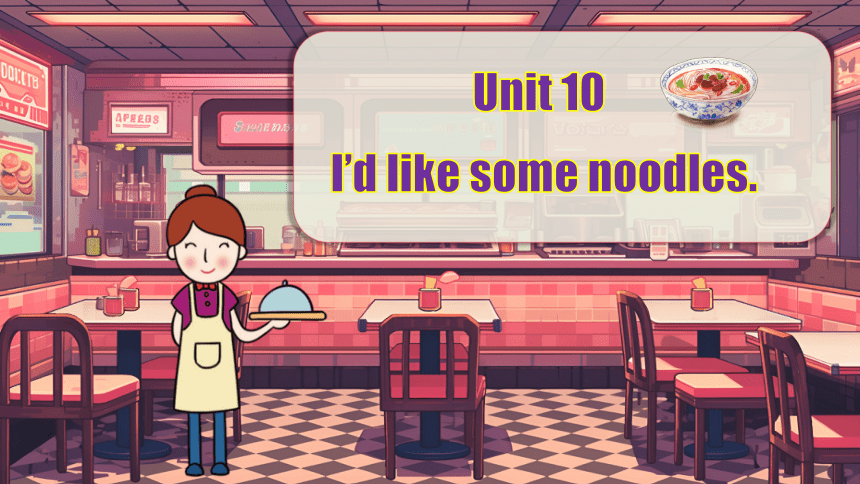 | |
| 格式 | pptx | ||
| 文件大小 | 211.6MB | ||
| 资源类型 | 试卷 | ||
| 版本资源 | 人教新目标(Go for it)版 | ||
| 科目 | 英语 | ||
| 更新时间 | 2024-05-06 20:50:02 | ||
图片预览

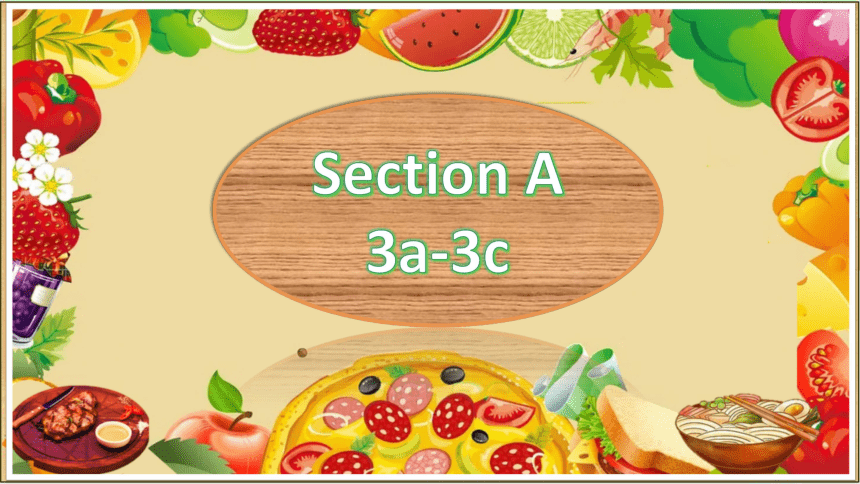
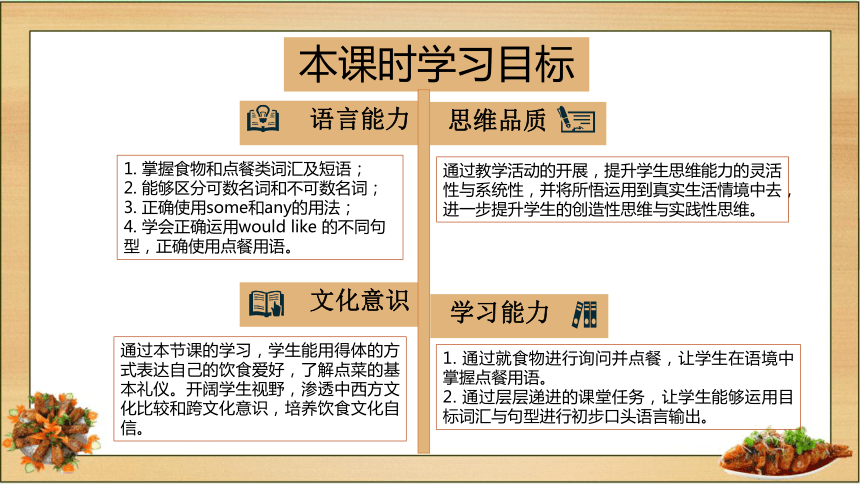
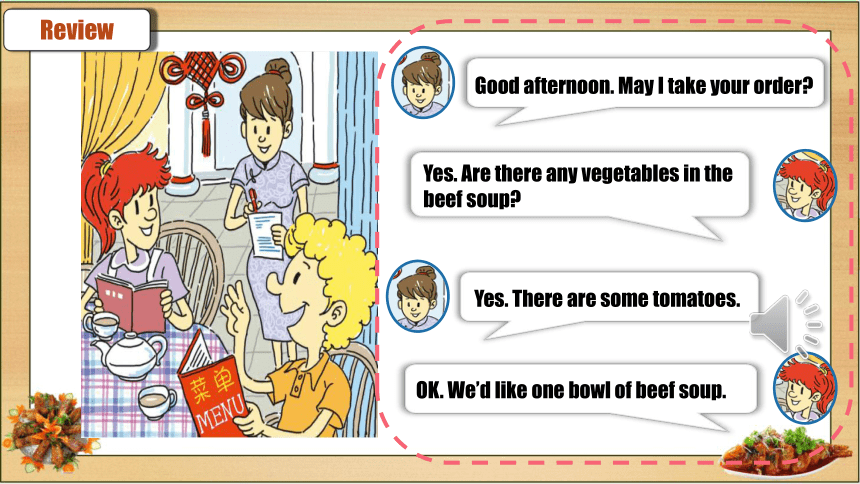
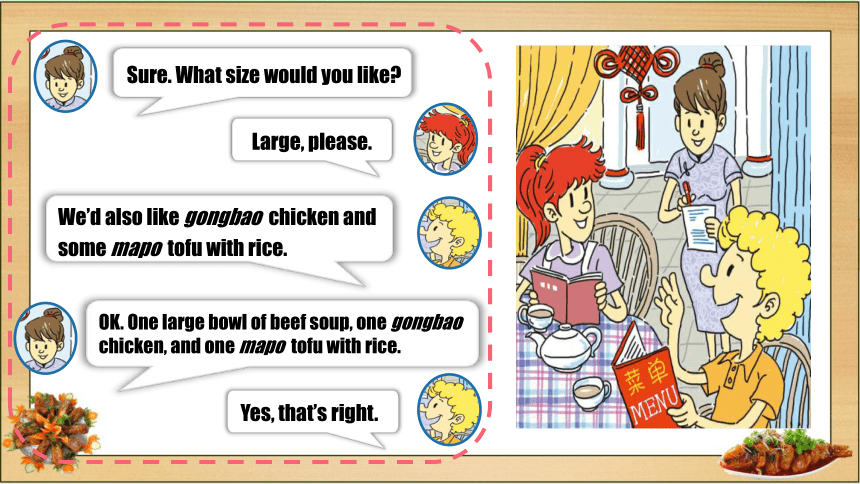

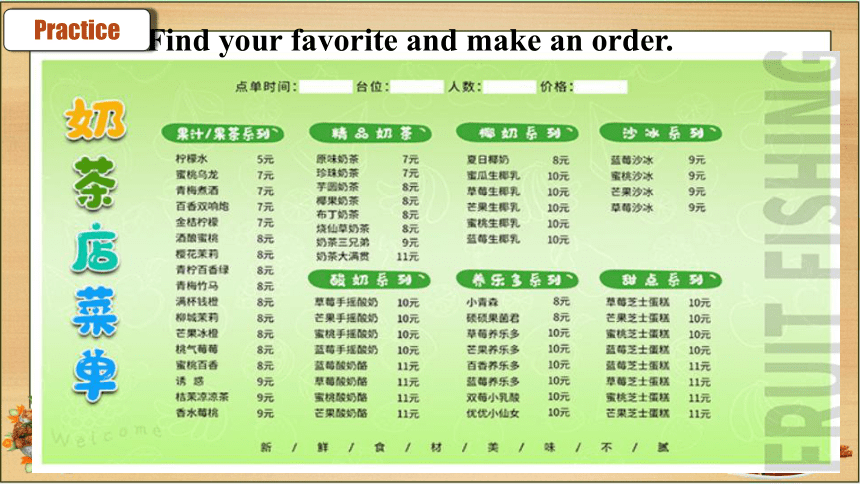
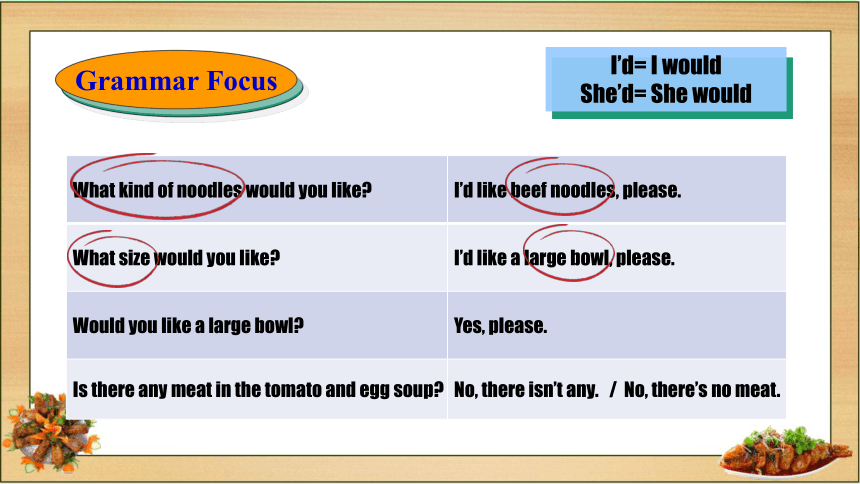
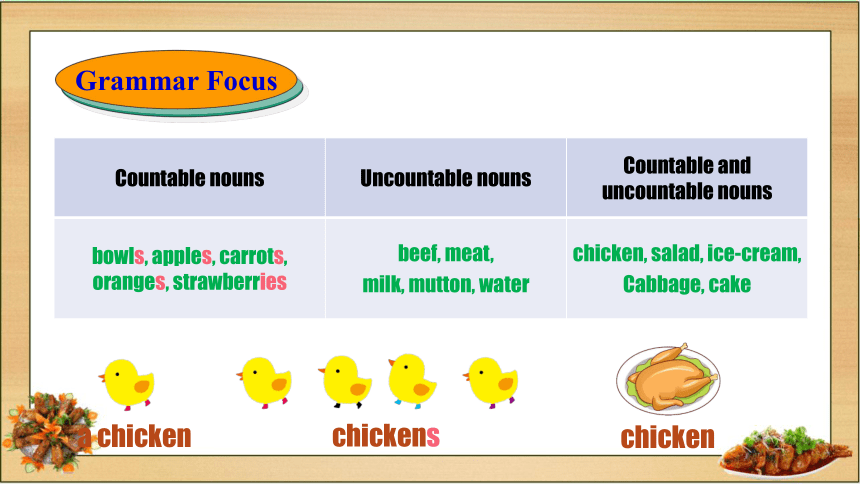
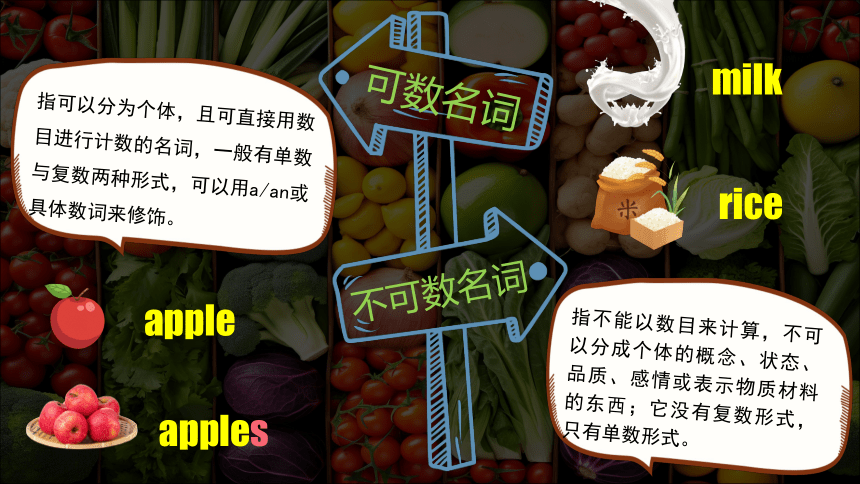
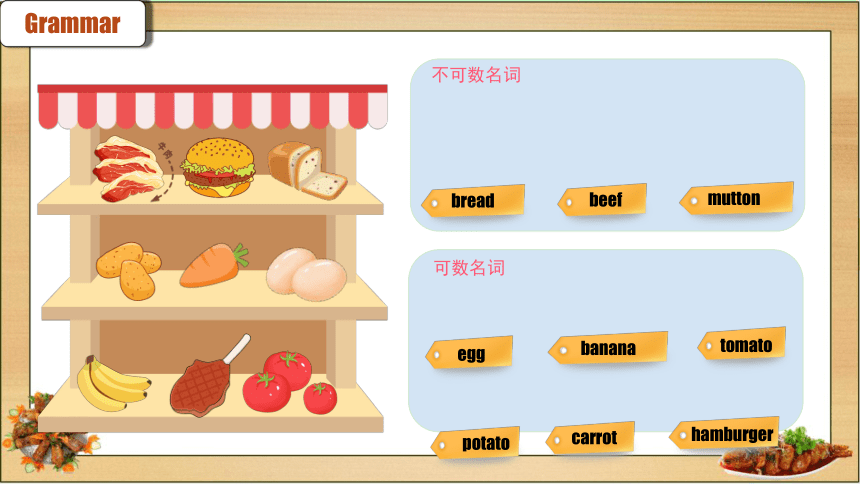

文档简介
(共44张PPT)
I’d like some noodles.
Unit 10
Section A
3a-3c
本课时学习目标
语言能力
思维品质
文化意识
学习能力
1. 掌握食物和点餐类词汇及短语;
2. 能够区分可数名词和不可数名词;
3. 正确使用some和any的用法;
4. 学会正确运用would like 的不同句型,正确使用点餐用语。
通过教学活动的开展,提升学生思维能力的灵活性与系统性,并将所悟运用到真实生活情境中去,进一步提升学生的创造性思维与实践性思维。
1. 通过就食物进行询问并点餐,让学生在语境中掌握点餐用语。
2. 通过层层递进的课堂任务,让学生能够运用目标词汇与句型进行初步口头语言输出。
通过本节课的学习,学生能用得体的方式表达自己的饮食爱好,了解点菜的基本礼仪。开阔学生视野,渗透中西方文化比较和跨文化意识,培养饮食文化自信。
Good afternoon. May I take your order
Yes. Are there any vegetables in the beef soup
Yes. There are some tomatoes.
OK. We’d like one bowl of beef soup.
Review
Large, please.
We’d also like gongbao chicken and some mapo tofu with rice.
OK. One large bowl of beef soup, one gongbao chicken, and one mapo tofu with rice.
Yes, that’s right.
Sure. What size would you like
Practice
Find your favorite and make an order.
Find your favorite and make an order.
Practice
I’d= I would
She’d= She would
Grammar Focus
What kind of noodles would you like I’d like beef noodles, please.
What size would you like I’d like a large bowl, please.
Would you like a large bowl Yes, please.
Is there any meat in the tomato and egg soup No, there isn’t any. / No, there’s no meat.
Grammar Focus
Countable nouns Uncountable nouns Countable and uncountable nouns
bowls, apples, carrots, oranges, strawberries beef, meat, milk, mutton, water chicken, salad, ice-cream,
Cabbage, cake
chicken
chickens
a chicken
指可以分为个体,且可直接用数目进行计数的名词,一般有单数与复数两种形式,可以用a/an或具体数词来修饰。
指不能以数目来计算,不可以分成个体的概念、状态、品质、感情或表示物质材料的东西;它没有复数形式,只有单数形式。
可数名词
不可数名词
apple
apples
milk
rice
不可数名词
egg
banana
tomato
bread
potato
carrot
beef
hamburger
mutton
可数名词
Grammar
Grammar
可数名词复数变化规则
1
一般情况下直接在词尾加-s
book
books
2
以-s, -x, -ch, -sh 结尾的单词在词尾加-es
box
boxes
3
以辅音字母+y结尾变y为i再加es
baby
babies
Grammar
可数名词复数变化规则
4
以元音字母+y结尾在词尾加-s
toy
toys
5
以-o结尾有生命的在词尾加-es,无生命的在词尾加-s
tomato
tomatoes
piano
pianos
Let’s watch and learn!
a bag of rice
a bar of chocolate
a tin of coke
a bottle of milk
a loaf of bread
a kilo of apples
Grammar
不可数名词表示数量的多少时,必须与表示数量的名词连用。
1. Are there any vegetables in the beef soup
2. There are some tomatoes.
3. We’d also like gongbao chicken and some mapo tofu with rice.
4. Is there any meat in the tomato and egg soup
句式 some any
肯定句 一些 /
否定句 / 代替some表示一些
疑问句 希望得到对方肯定的回答 代替some表示一些
Grammar
some和any可以修饰可数名词复数和不可数名词
3a
Complete the conversation below.
1. May I have your order _____
2. What kind of noodles would you like _____
3. We have beef, chicken, mutton, cabbage, potato, tomato…____
4. Yes, there are some carrots._____
5. Sure. What size would you like _____
6. We have large, medium and small bowls.____
A: What kind of noodles do you have
B: Oh, a medium bowl, please.
C: OK, I’d like the mutton noodles then.
D: I’d like some noodles, please.
E: What sizes do you have
F: Are there any vegetables in the mutton noodles
d
a
f
c
e
b
3b
Write questions and answers using the words in brackets.
1. What kind of noodles would you like (kind)
__________________________________________________________________________________
(chicken / beef / tomatoes)
I’d like chicken, beef and tomato noodles.
I’d like chicken and beef noodles with tomatoes.
3b
Write questions and answers using the words in brackets.
2. __________________________________ (size)
_________________________________ (medium)
What size would you like
I’d like a medium bowl, please.
3b
Write questions and answers using the words in brackets.
3.________________________________________
(any / cabbage / beef noodles)
_________________________________
(no)
Is there any cabbage in the beef noodles
No, there isn’t any.
3c
Work in small groups. Find out who would like the food below. Write their names on the cards above the food.
A: Anna, what would you like to eat
B: I’d like beef noodles with carrots.
Make conversations with your partners .
What would you like to eat
I’d like chicken noodles with vegetables.
What size would you like
I’d like a medium bowl, please.
What would you like
Let’s talk!
How many \ much would you like
13 dumplings
What would you like
How many \ much would you like
bananas
apples
What would you like
How many \ much would you like
2 bowls of rice
5 slices of bread
3 plates of tofu
Watch the video and discuss how we can save food.
Language Points
1
May I take your order 你们现在点餐吗
order 此处做名词,意为“点菜,订购”。take one’s order 意为“记下某人点的菜;点菜”。
Please take your order. 请您点菜。
I want to give the bookshop an order for this book.
我想向书店订购这本书。
Language Points
1
May I take your order 你们现在点餐吗
【拓展】
①order 做名词,还可意为“次序;顺序”。
Put the sentences in right order. 按正确的顺序排列句子。
②order 做动词,意为“点菜;预订;命令”。
I'd like to order some noodles. 我想点些面条。
Shall I order a taxi for you 要我给你叫辆出租车吗
My father orders me to clean my room every day.
爸爸命令我每天打扫我的房间。
Language Points
2
We'd like one bowl of beef soup. 我们想要一碗牛肉汤。
one/a bowl of.. 表示“一碗……”,后跟可数名词复数或不可数名词。类似的用法还有:a glass/cup of“一杯”;a bottle of“一瓶”。
Would you like a bowl of noodles for breakfast
早饭你想吃一碗面条吗
【注意】
当数词超过“一”时,量词变为相应的复数形式;of后面的名词用可数名词的复数形式或不可数名词。
I'd like two bowls of rice for lunch.
午饭我想吃两碗米饭。
Language Points
3
—What size would you like 你们想要多大碗的
— Large, please. 来一大碗的。
①“What size ... ”常用来询问物体的大小、尺寸。
What size is your apartment 你的公寓多大?
-What size shoes does your father take 你爸爸穿多大号的鞋?
-He takes size 8 in shoes. 他穿8号的鞋。
②large形容词,意为“大号的;大的”。
It’s a large room. 这是一个大房间。
4. some和 any 的用法:
some一般用于肯定句中, 意思是“几个”、“一些”、“某个”作定语时可修饰可数名词或不可数名词。
I have some work to do today.
今天我有些事情要做。
some 用于疑问句时,表示建议、请求或希望得到肯定回答。
Would you like some coffee with sugar
你要加糖的咖啡吗?
any 一般用于疑问句或否定句中, 意思是“任何一些”、“任何一个”, 作定语时可修饰可数或不可数名词。
They didn’t have any friends here.
他们在这里没有朋友。
any 用于肯定句时, 意思是“任何的”。
Come here with any friend.
随便带什么朋友来吧。
用some和any填空
1. There isn’t ______ milk in the fridge.
2. I can see ______ cars, but I can’t see ______ buses.
3. He has ______ friends in England.
4. Do you want to take ______ photos
5. Is there ______ rice in the kitchen
any
some
any
some
any
any
名词分类:可数名词和不可数名词
可数名词的用法:
①有单数和复数两种形式。
eg:a book;two books
②可以直接用不定冠词a/an或数词来修饰单数形式。
eg:a cake;an apple
③可以用some,any,few,a few,many,a lot of等来修饰复数形式。
eg:some girls;a few friends
④用how many来询问数量的多少。
eg:How many people are there in your family
⑤单个单数名词作主语时, 谓语动词要用单数形式, 多个单数名词或复数名词作主语时, 谓语动词要用复数形式。
eg:Jim comes from England.杰姆来自英国。
Lily and Lucy are twins.丽丽和露西是双胞胎。
不可数名词的用法:
①只有一种形式。
eg:bread;juice;milk;water;tea;meat
②不能用不定冠词或数词直接修饰,可用“量词+of”这种形式来表示数量的多少,量词有复数形式。
eg:two cups of tea;three bowls of rice
③可以用some, any, little, a little, much, a lot of等来修饰。
eg:some milk;a little tea
④用how much来询问数量的多少。
eg:How much milk is there in the bottle
⑤不可数名词作主语时, 谓语动词用单数形式, 但是, 当不可数名词前有复数名词短语修饰时, 谓语动词就要用复数形式。
eg:There is some water in the glass.
There are three bottles of water on the table.
1
Would you like ____ hot soup
A. little B. much C. some D. any
I would like ______ in my noodles.
A. tomatoes and mutton B. tomatoes and muttons
C. tomato and mutton D. tomato and muttons
2
Exercise
一、单项选择。
—What’s in the noodles
—There ________ some beef and vegetables in the noodles.
A. is B. are C. has D. be
3
二、按要求完成下列句子。
6.There is a book on the desk.(改为复数句)
There _____ _______ _______ on the desk.
7.He'd like two glasses of water.(对画线部分提问)
______ ______ water would he like
8.Would you like two oranges?(肯定回答)
_____, __________.
9.Mary would like beef noodles.(对画线部分提问)
_______ _______ ____ noodles ________ Mary_______
10.我想要一杯茶。(翻译句子)
I ______ _______ a cup of tea.
are some books
How much
please
What kind of
would
like
would like
1. I would like ________ tea and coffee.
2. There isn’t ________ ink(墨水) in my pen.
3. Could I have ________ beer, please
4. You can buy this book at ________ bookstore in our city.
5. -There is no salt left. Jim, would you like to get ________
-OK, Mum.
三、用some/any填空。
some
any
some
any
some
1. — Would you like ________ (go) to the movies with us
— Sure, I’d love to.
2. Look at these big __________ (tomato). I think they must be very delicious.
3. Mr. Green has many _________ (chicken) because he likes eating ________ (chicken).
4. Jane would like some ____________ (strawberry).
四、用单词的适当形式填空。
to go
tomatoes
chickens
strawberries
chicken
Summary
Words and Phrases:
take one’s order, what size, a large bowl, a medium bowl, a small bowl, tofu, meat
1
Sentences:
-What kind of noodles would you like
-I’d like beef noodles, please.
2
Grammar:
①可数名词:指可以分为个体,且可直接用数目进行计数的名词。
②不可数名词:指不能以数目来计算,不可以分成个体的概念、状态、品质、感情或表示物质材料的东西。
③some和any可以修饰可数名词复数和不可数名词;some常译作“一些”,多用于肯定句,也用在疑问句中,表示期望对方肯定的答复,以示礼貌;any表示“任何”,通常用于否定句和疑问句中。
3
Summary
1. Remember the sentences in the Grammar Focus.
2. Tell the difference between countable nouns and uncountable nouns.
3. Complete the exercises.
Homework
Thank you !
I’d like some noodles.
Unit 10
Section A
3a-3c
本课时学习目标
语言能力
思维品质
文化意识
学习能力
1. 掌握食物和点餐类词汇及短语;
2. 能够区分可数名词和不可数名词;
3. 正确使用some和any的用法;
4. 学会正确运用would like 的不同句型,正确使用点餐用语。
通过教学活动的开展,提升学生思维能力的灵活性与系统性,并将所悟运用到真实生活情境中去,进一步提升学生的创造性思维与实践性思维。
1. 通过就食物进行询问并点餐,让学生在语境中掌握点餐用语。
2. 通过层层递进的课堂任务,让学生能够运用目标词汇与句型进行初步口头语言输出。
通过本节课的学习,学生能用得体的方式表达自己的饮食爱好,了解点菜的基本礼仪。开阔学生视野,渗透中西方文化比较和跨文化意识,培养饮食文化自信。
Good afternoon. May I take your order
Yes. Are there any vegetables in the beef soup
Yes. There are some tomatoes.
OK. We’d like one bowl of beef soup.
Review
Large, please.
We’d also like gongbao chicken and some mapo tofu with rice.
OK. One large bowl of beef soup, one gongbao chicken, and one mapo tofu with rice.
Yes, that’s right.
Sure. What size would you like
Practice
Find your favorite and make an order.
Find your favorite and make an order.
Practice
I’d= I would
She’d= She would
Grammar Focus
What kind of noodles would you like I’d like beef noodles, please.
What size would you like I’d like a large bowl, please.
Would you like a large bowl Yes, please.
Is there any meat in the tomato and egg soup No, there isn’t any. / No, there’s no meat.
Grammar Focus
Countable nouns Uncountable nouns Countable and uncountable nouns
bowls, apples, carrots, oranges, strawberries beef, meat, milk, mutton, water chicken, salad, ice-cream,
Cabbage, cake
chicken
chickens
a chicken
指可以分为个体,且可直接用数目进行计数的名词,一般有单数与复数两种形式,可以用a/an或具体数词来修饰。
指不能以数目来计算,不可以分成个体的概念、状态、品质、感情或表示物质材料的东西;它没有复数形式,只有单数形式。
可数名词
不可数名词
apple
apples
milk
rice
不可数名词
egg
banana
tomato
bread
potato
carrot
beef
hamburger
mutton
可数名词
Grammar
Grammar
可数名词复数变化规则
1
一般情况下直接在词尾加-s
book
books
2
以-s, -x, -ch, -sh 结尾的单词在词尾加-es
box
boxes
3
以辅音字母+y结尾变y为i再加es
baby
babies
Grammar
可数名词复数变化规则
4
以元音字母+y结尾在词尾加-s
toy
toys
5
以-o结尾有生命的在词尾加-es,无生命的在词尾加-s
tomato
tomatoes
piano
pianos
Let’s watch and learn!
a bag of rice
a bar of chocolate
a tin of coke
a bottle of milk
a loaf of bread
a kilo of apples
Grammar
不可数名词表示数量的多少时,必须与表示数量的名词连用。
1. Are there any vegetables in the beef soup
2. There are some tomatoes.
3. We’d also like gongbao chicken and some mapo tofu with rice.
4. Is there any meat in the tomato and egg soup
句式 some any
肯定句 一些 /
否定句 / 代替some表示一些
疑问句 希望得到对方肯定的回答 代替some表示一些
Grammar
some和any可以修饰可数名词复数和不可数名词
3a
Complete the conversation below.
1. May I have your order _____
2. What kind of noodles would you like _____
3. We have beef, chicken, mutton, cabbage, potato, tomato…____
4. Yes, there are some carrots._____
5. Sure. What size would you like _____
6. We have large, medium and small bowls.____
A: What kind of noodles do you have
B: Oh, a medium bowl, please.
C: OK, I’d like the mutton noodles then.
D: I’d like some noodles, please.
E: What sizes do you have
F: Are there any vegetables in the mutton noodles
d
a
f
c
e
b
3b
Write questions and answers using the words in brackets.
1. What kind of noodles would you like (kind)
__________________________________________________________________________________
(chicken / beef / tomatoes)
I’d like chicken, beef and tomato noodles.
I’d like chicken and beef noodles with tomatoes.
3b
Write questions and answers using the words in brackets.
2. __________________________________ (size)
_________________________________ (medium)
What size would you like
I’d like a medium bowl, please.
3b
Write questions and answers using the words in brackets.
3.________________________________________
(any / cabbage / beef noodles)
_________________________________
(no)
Is there any cabbage in the beef noodles
No, there isn’t any.
3c
Work in small groups. Find out who would like the food below. Write their names on the cards above the food.
A: Anna, what would you like to eat
B: I’d like beef noodles with carrots.
Make conversations with your partners .
What would you like to eat
I’d like chicken noodles with vegetables.
What size would you like
I’d like a medium bowl, please.
What would you like
Let’s talk!
How many \ much would you like
13 dumplings
What would you like
How many \ much would you like
bananas
apples
What would you like
How many \ much would you like
2 bowls of rice
5 slices of bread
3 plates of tofu
Watch the video and discuss how we can save food.
Language Points
1
May I take your order 你们现在点餐吗
order 此处做名词,意为“点菜,订购”。take one’s order 意为“记下某人点的菜;点菜”。
Please take your order. 请您点菜。
I want to give the bookshop an order for this book.
我想向书店订购这本书。
Language Points
1
May I take your order 你们现在点餐吗
【拓展】
①order 做名词,还可意为“次序;顺序”。
Put the sentences in right order. 按正确的顺序排列句子。
②order 做动词,意为“点菜;预订;命令”。
I'd like to order some noodles. 我想点些面条。
Shall I order a taxi for you 要我给你叫辆出租车吗
My father orders me to clean my room every day.
爸爸命令我每天打扫我的房间。
Language Points
2
We'd like one bowl of beef soup. 我们想要一碗牛肉汤。
one/a bowl of.. 表示“一碗……”,后跟可数名词复数或不可数名词。类似的用法还有:a glass/cup of“一杯”;a bottle of“一瓶”。
Would you like a bowl of noodles for breakfast
早饭你想吃一碗面条吗
【注意】
当数词超过“一”时,量词变为相应的复数形式;of后面的名词用可数名词的复数形式或不可数名词。
I'd like two bowls of rice for lunch.
午饭我想吃两碗米饭。
Language Points
3
—What size would you like 你们想要多大碗的
— Large, please. 来一大碗的。
①“What size ... ”常用来询问物体的大小、尺寸。
What size is your apartment 你的公寓多大?
-What size shoes does your father take 你爸爸穿多大号的鞋?
-He takes size 8 in shoes. 他穿8号的鞋。
②large形容词,意为“大号的;大的”。
It’s a large room. 这是一个大房间。
4. some和 any 的用法:
some一般用于肯定句中, 意思是“几个”、“一些”、“某个”作定语时可修饰可数名词或不可数名词。
I have some work to do today.
今天我有些事情要做。
some 用于疑问句时,表示建议、请求或希望得到肯定回答。
Would you like some coffee with sugar
你要加糖的咖啡吗?
any 一般用于疑问句或否定句中, 意思是“任何一些”、“任何一个”, 作定语时可修饰可数或不可数名词。
They didn’t have any friends here.
他们在这里没有朋友。
any 用于肯定句时, 意思是“任何的”。
Come here with any friend.
随便带什么朋友来吧。
用some和any填空
1. There isn’t ______ milk in the fridge.
2. I can see ______ cars, but I can’t see ______ buses.
3. He has ______ friends in England.
4. Do you want to take ______ photos
5. Is there ______ rice in the kitchen
any
some
any
some
any
any
名词分类:可数名词和不可数名词
可数名词的用法:
①有单数和复数两种形式。
eg:a book;two books
②可以直接用不定冠词a/an或数词来修饰单数形式。
eg:a cake;an apple
③可以用some,any,few,a few,many,a lot of等来修饰复数形式。
eg:some girls;a few friends
④用how many来询问数量的多少。
eg:How many people are there in your family
⑤单个单数名词作主语时, 谓语动词要用单数形式, 多个单数名词或复数名词作主语时, 谓语动词要用复数形式。
eg:Jim comes from England.杰姆来自英国。
Lily and Lucy are twins.丽丽和露西是双胞胎。
不可数名词的用法:
①只有一种形式。
eg:bread;juice;milk;water;tea;meat
②不能用不定冠词或数词直接修饰,可用“量词+of”这种形式来表示数量的多少,量词有复数形式。
eg:two cups of tea;three bowls of rice
③可以用some, any, little, a little, much, a lot of等来修饰。
eg:some milk;a little tea
④用how much来询问数量的多少。
eg:How much milk is there in the bottle
⑤不可数名词作主语时, 谓语动词用单数形式, 但是, 当不可数名词前有复数名词短语修饰时, 谓语动词就要用复数形式。
eg:There is some water in the glass.
There are three bottles of water on the table.
1
Would you like ____ hot soup
A. little B. much C. some D. any
I would like ______ in my noodles.
A. tomatoes and mutton B. tomatoes and muttons
C. tomato and mutton D. tomato and muttons
2
Exercise
一、单项选择。
—What’s in the noodles
—There ________ some beef and vegetables in the noodles.
A. is B. are C. has D. be
3
二、按要求完成下列句子。
6.There is a book on the desk.(改为复数句)
There _____ _______ _______ on the desk.
7.He'd like two glasses of water.(对画线部分提问)
______ ______ water would he like
8.Would you like two oranges?(肯定回答)
_____, __________.
9.Mary would like beef noodles.(对画线部分提问)
_______ _______ ____ noodles ________ Mary_______
10.我想要一杯茶。(翻译句子)
I ______ _______ a cup of tea.
are some books
How much
please
What kind of
would
like
would like
1. I would like ________ tea and coffee.
2. There isn’t ________ ink(墨水) in my pen.
3. Could I have ________ beer, please
4. You can buy this book at ________ bookstore in our city.
5. -There is no salt left. Jim, would you like to get ________
-OK, Mum.
三、用some/any填空。
some
any
some
any
some
1. — Would you like ________ (go) to the movies with us
— Sure, I’d love to.
2. Look at these big __________ (tomato). I think they must be very delicious.
3. Mr. Green has many _________ (chicken) because he likes eating ________ (chicken).
4. Jane would like some ____________ (strawberry).
四、用单词的适当形式填空。
to go
tomatoes
chickens
strawberries
chicken
Summary
Words and Phrases:
take one’s order, what size, a large bowl, a medium bowl, a small bowl, tofu, meat
1
Sentences:
-What kind of noodles would you like
-I’d like beef noodles, please.
2
Grammar:
①可数名词:指可以分为个体,且可直接用数目进行计数的名词。
②不可数名词:指不能以数目来计算,不可以分成个体的概念、状态、品质、感情或表示物质材料的东西。
③some和any可以修饰可数名词复数和不可数名词;some常译作“一些”,多用于肯定句,也用在疑问句中,表示期望对方肯定的答复,以示礼貌;any表示“任何”,通常用于否定句和疑问句中。
3
Summary
1. Remember the sentences in the Grammar Focus.
2. Tell the difference between countable nouns and uncountable nouns.
3. Complete the exercises.
Homework
Thank you !
同课章节目录
- Unit 1 Can you play the guitar?
- Section A
- Section B
- Unit 2 What time do you go to school?
- Section A
- Section B
- Unit 3 How do you get to school?
- Section A
- Section B
- Unit 4 Don't eat in class.
- Section A
- Section B
- Unit 5 Why do you like pandas?
- Section A
- Section B
- Unit 6 I'm watching TV.
- Section A
- Section B
- Review of Units 1-6
- Unit 7 It's raining!
- Section A
- Section B
- Unit 8 Is there a post office near here?
- Section A
- Section B
- Unit 9 What does he look like?
- Section A
- Section B
- Unit 10 I'd like some noodles.
- Section A
- Section B
- Unit 11 How was your school trip?
- Section A
- Section B
- Unit 12 What did you do last weekend?
- Section A
- Section B
